Jitendra Das: It is more important that the person is happy and non-violent than the style of yoga they practice
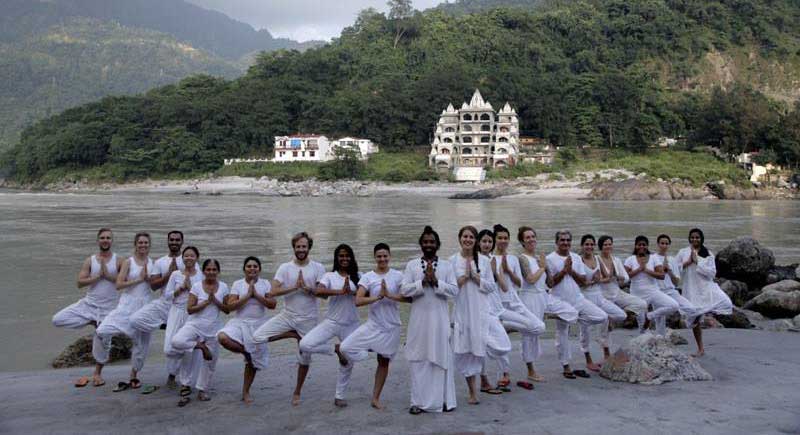
Jitendra Das is one of the well-known teachers in Rishikesh who teaches a traditional approach to yoga based on ancient scriptures and sources. He has founded his ashram, Patanjali International Yoga Foundation, in Rishikesh in 2001, and since then he has taught hundreds of people on his courses in Rishikesh and in workshops all around the world. TopYogis had a conversation with Dr. Jitendra Das about his approach to yoga. 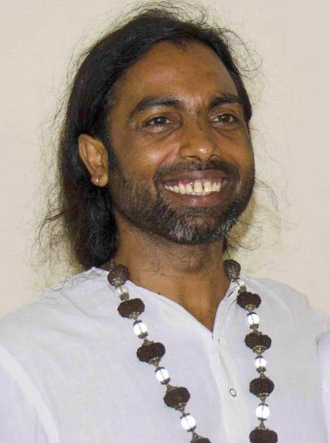
TopYogis: Jitendra Ji, tell us how your path in yoga started?
Jitendra Das: I started my path in a very natural way, without any expectations, hopes or plans towards opening any business. It just happened, it was a process of seeking and searching, and in this journey, I went to a school, then to the university, and then I completed the Ph.D., and then I still continued searching, and we are here in front of Ganga for the search. So it is a journey, and this journey is still going on.
What is yoga practice for you? What is the purpose of yoga practice? Why do you think we should practice yoga?
Practicing yoga for me or you are asking about the purpose of yoga practice in this world?
Both for you and for the world.
I just practice. Why I practice - even I don’t have an answer to it. So many things are happening in the Universe and you don’t have any answer. Why does the sun come? No answer. Why does the winter come? No answer. Some things have no explanation.
And if you ask about this world, why is it important to practice yoga in this world, in yoga we talk about non-violence. Imagine if non-violence happened everywhere in this world. Each person, each human being is looking for love. So love will come itself if you remove the violence. So if we practice yoga and practice non-violence, love comes. You can see that those people who practice yoga, they are different. They have a different mind. They want to solve everything (problems and conflicts) with love, with calmness, without fighting.
It will be much more helpful in this world if more people practiced yoga. Give love, receive love, and there will be no violence in this world.
Sometimes in the West you see people doing a lot of yoga, but it is only a physical part, and sometimes they seem to be doing violence to their own body. In India, we see many different approaches to yoga, sometimes a deeper insight into yoga, not just a physical part but other things. How important are these “other” aspects of yoga practice?
I will say, however people practice in this world (is good). In the East, in the West, for the physical, for the mind, for the spirit, however. Let them practice. At least they are doing yoga. At least they are not harming, not doing violence. Even those who are doing physical practice. When you get physically fit, you will get mentally fit also. So my point is, when they practice yoga, they are already on the way to becoming better, a good person, non-violent. In my opinion, it does not even matter the purpose with which people are doing yoga, even if they do only physical. Because they are still doing yoga, any part of yoga is yoga. Somebody sent me a video of people drinking beer and doing yoga and asked my opinion. I said, at least they are doing yoga. They are not hurting anybody. You should see the positive point. At least they are not getting aggressive in any form. They are drinking, they are doing yoga, they calm themselves, and they are happy. We should see the positive point (in any type of practice).
This is more important that the person is happy, and they bring no violence to this world. For me, this is more important than the style and kind of yoga they are doing.
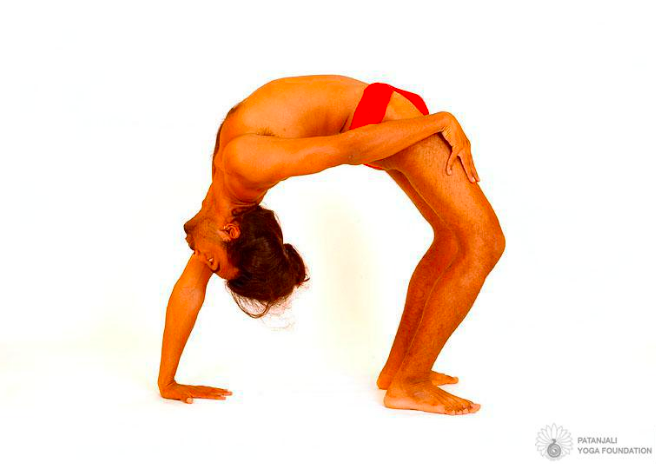 Many students around the world are interested in the personal practice of yoga teachers. Can you tell us about your yoga practice?
Many students around the world are interested in the personal practice of yoga teachers. Can you tell us about your yoga practice?
When I was a student, I had no responsibilities, no work, and lots of time, I was depending on somebody - my guardians paid for everything, took care of expenses. You only go to the school and come back. We had more time, so we practiced for two hours in the morning, two hours in the evening, all day long we were studying some yoga books. And then I completed my education but had no work yet, and there was a lot of time to practice, 8 hours a day. And then we came in our teaching life. You need to teach 4 hours, 6 hours a day, you have less time to practice yourself. Maybe you have 2 hours in the morning for practice, and maybe no time in the evening. And now we got a small ashram, more responsibilities, busier life.
When you organize and manage, you wake up early in the morning, this is your time. If you practice, it is yours. You don’t practice - time is gone. Then you are traveling. And sometimes you travel from Moscow to Vladivostok for ten hours. You cannot practice during the flight, and after you reach the city, there is no time to practice, you feel tired. So I cannot say that I practice regularly. Sometimes I want to practice, but time does not allow.
Some people in the West are very busy and they have really little time for personal practice. If a person had only fifteen minutes a day for yoga practice, what would you recommend them to do?
I can believe it because I know what it is to be very busy. Many times we ran intensive yoga courses, so we know what is a busy time. Whatever time we have - sometimes we might have only 10 minutes - if your body allows it, and mind allows it, do something.
I will not give specific practices, it depends on what you like. If you like stretching, stretch. If you like meditation, sit and meditate. If you like to make pranayama, do it.
Once we were in the airport, and there were trolleys there to carry the baggage. I saw one Western guy, he was sitting on the trolley and was doing pranayama. In the airport. So I will say, it depends on how much time we have and what we like - pranayama, asana, stretching - do something for your body and mind. At least these 5 minutes, 10 minutes, 15 minutes will make you happy for entire day. Doing anything is better then sleeping and being lazy. It’s better to be active than being lazy.
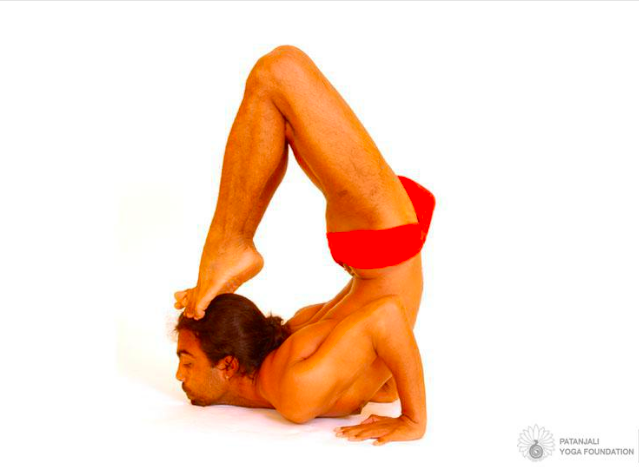 Jitendra Ji, what is your opinion on pain? When we try to do some asana, and we feel that something is painful, should we push through the pain, or should we avoid the pain?
Jitendra Ji, what is your opinion on pain? When we try to do some asana, and we feel that something is painful, should we push through the pain, or should we avoid the pain?
Regarding pain, there is no space for pain in yoga, if you mean ancient system. In the ancient technique, Patanjali said: "Sthiram sukham asanam”. Asana, your practice should be pleasant. It is a very deep, ancient technique. Do according to your physical level, and if you do according to your physical level, day by day you will improve. And imagine if today you stretch too much, tomorrow your body will feel pain, you will have to stop your practice, and how long will you have to wait to fix your pain? Maybe for three, four, five days? Within this time, your practice, your flexibility is gone. And then you start again, and again you over-stretch, and it goes on. So over-stretching has no place in yoga. Sometimes your body is heavy, tired. Maybe you did not sleep, maybe you traveled in the flight, maybe you went to a cold place, maybe the weather has changed. In these conditions, there is no need to over-stretch. Listen to your body, practice according to what you feel. Maybe from a cold place you will travel to a warmer place, and your body will open by itself.
So, we should listen to our body, and the body will tell you what to do, and that way keep doing, keep growing, keep moving.
In your practice, did you ever have injuries that were related to yoga or happened because of yoga?
I will say no. I didn’t have injuries and during my teaching, I do not have students who get injured. Yoga is not related to an injury.
Yoga means concentration. If you practice with concentration, there is no injury. The person gets injured only if they lose the concentration.
Even if you walk and you lose the concentration, you can get injured. Person doing anything can get injured when they lose the concentration. Even while you’re eating or speaking and you lost your concentration, you can bite your tongue. So yoga means concentration. You practice with awareness, listen to your body, and then there is no injury. If there is injury, it means this is not yoga. In have been conducting courses since 2001, and I did not find any student who got injured in my class. So just keep going, keep growing.
What is your opinion on adjustment? Should a teacher adjust their students, or should the students understand themselves how to perform their asanas?
If you ask about the teaching, in the teaching comes everything. You need to make demo, you need to speak, and also you should go and touch the student to adjust. But it depends, because if the student says no, you should listen to the student, respect them and not touch. Also, you should listen to the student’s body. Sometimes you touch the body, and then you can help. Listen to the student’s body, how far it can go. Don’t over-force. Don’t over-stretch, don’t over-press. You put your hand and then you listen. Their body tells you what is the person’s ability. Some students are flexible, but they don’t use their flexibility, and some are so hard and tight. So if they are flexible, you touch them, you feel their ability, and you go according to their flexibility. If somebody is stiff, go according to their flexibility. And if some students say “do not adjust me”, you should listen to them also.
Everything - adjusting, speaking, demonstration - is a part of the teaching. This is why a person goes to learn with a yoga teacher. The teacher can help them, support them, let them know that they are so flexible. But at the same time, we as teachers should be flexible also and know where to touch, where not to touch, where to support with words.
We cannot say that it’s compulsory to touch or that you should never adjust the student. Everyting depends on the situation.
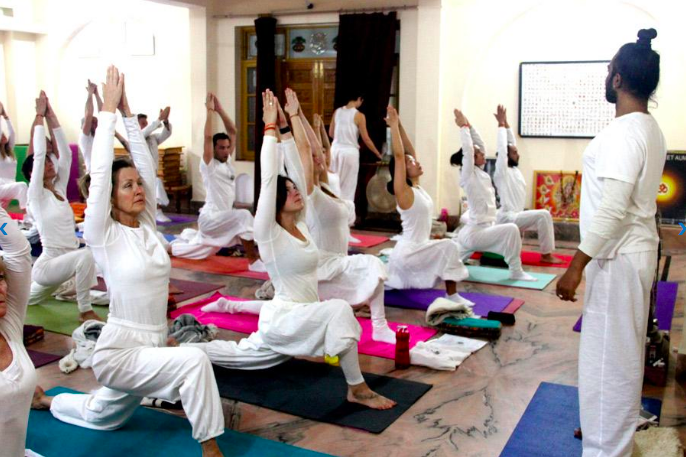 What is your position regarding headstand? We are asking this question because sometimes there is a controversy over this posture. Some teachers don’t like to teach it because they think many Western people do not have bodies that are prepared for it, and some teachers like the headstand. What do you think about it?
What is your position regarding headstand? We are asking this question because sometimes there is a controversy over this posture. Some teachers don’t like to teach it because they think many Western people do not have bodies that are prepared for it, and some teachers like the headstand. What do you think about it?
This is a good question, because it’s about the teaching part. You are saying that headstand is dangerous, but everything is dangerous in this world. Vehicles, planes are very helpful. In a few hours, you can travel to another part of the world. But then some accidents can happen. The same things we can say about Shirshasana.
If you are a proper teacher, then as a teacher you know if a student’s body is ready or not ready. If the body is ready, then the teaching is not dangerous, practice is not dangerous. But if the body is not ready, the person is not ready, then the teaching can be dangerous.
What is ready? If a person’s shoulders, scapula are not open, their neck is tight, if somebody has problems with eye sight, brain haemorrhage, high blood pressure, they are not ready. In Shirsasana, the blood pressure goes so high that it can be harmful to those who have very high blood pressure. I will say that as teachers, we should prepare students for any position.
My personal approach, I prepare students’ bodies for every position. And during the preparation, I can see who can practice the posture, and who is not able to do it yet. And those people who are able to do the posture, I help them more. And to those who are not able, I say you prepare your body.
Imagine that somebody’s shoulder is so tight that he cannot lift the elbow to be in line with his head. His shoulders and elbows will not be able to support the posture and the pressure can go on the person’s head and neck. If the elbow can be in line with the head, the pressure will go on the forearm and on the scapula, not on the neck. If the body is not ready and the shoulder is blocked, there is no mobility, then the posture can be dangerous. When teaching postures, you should be flexible, see the body of the student, and then according to it you should follow and modify your instructions if necessary: with the wall, without the wall, half-shirshasana, full shirshasana. And then, Shirshasana has hundreds of variations. If the body and mind is ready, go ahead. If you are not ready, then get ready on the physical level and practice. It’s going to work, don’t worry.
A lot of people come to Rishikesh to learn yoga. But it’s so many yoga schools here that it’s difficult to make a decision where to go. Would you give any advice for someone who comes to Rishikesh, how to choose a good teacher?
You can see that in Rishikesh every day some new constructions starts. And in every construction, at least on the rooftop they have yoga. It’s good, at least we have a lot of activity here.
But how to chose yoga? First thing, many people are coming through the Internet, because it’s much more easy and comfortable, you know where you’re going, there is a room, food, accommodation, and you’re not wasting time for searching. How do we choose? There is one proverb: every teacher finds their student, and every student finds their teacher. Keep searching, search online, talk with your friends and family, your relatives, and when you decide, you come. In this way, you can find your teacher.
Our students also come through the Internet search. Some students ask online those who have been in India, they ask about other people’s experiences, and then they have a good idea, good feeling. And when they come here, both sides feel comfortable, the student who came, and the center that hosts him, because the person has some idea about the course and practice.
I will advise anyone traveling from their country, decide on your school online and stick with it. You don’t need to search any more here. Otherwise, you will come for a month and if you go to a center that you don’t know (without any previous sign up), their course may start in a few days, in a week - you’re losing your time. Decide on the style - there is ashtanga vinyasa, there is hatha yoga, Patanjali yoga, other styles. And students who want to come here for a teacher training, they already practice yoga, maybe for six months, one year, five years. So according to their experience, preference of style and expectations they can search online and get the recommendations. And then you come and have a place ready for you, so you don’t need to search here and there.
You can contact Dr. Jitendra Das and see where he is teaching at his TopYogis page. If you have practiced with him you can share your experience there.
Find hatha yoga teachers in Rishikesh
Find hatha yoga instructors around the world.
Find yoga teachers in Rishikesh (all styles)
Find yoga schools in Rishikesh.
If you're a yoga teacher, create your profile page on TopYogis. Here's what it can give you.
All pictures were taken from Patanjali International Yoga Foundation
